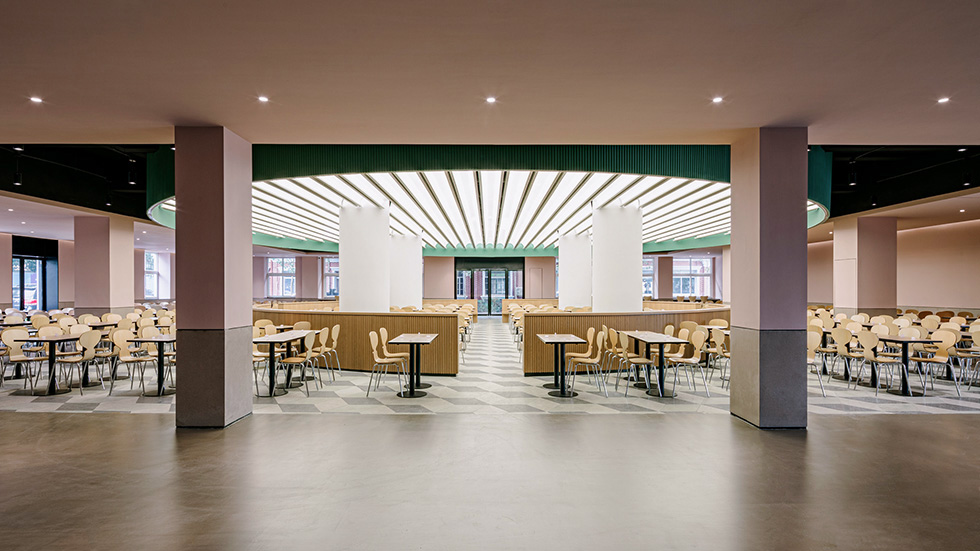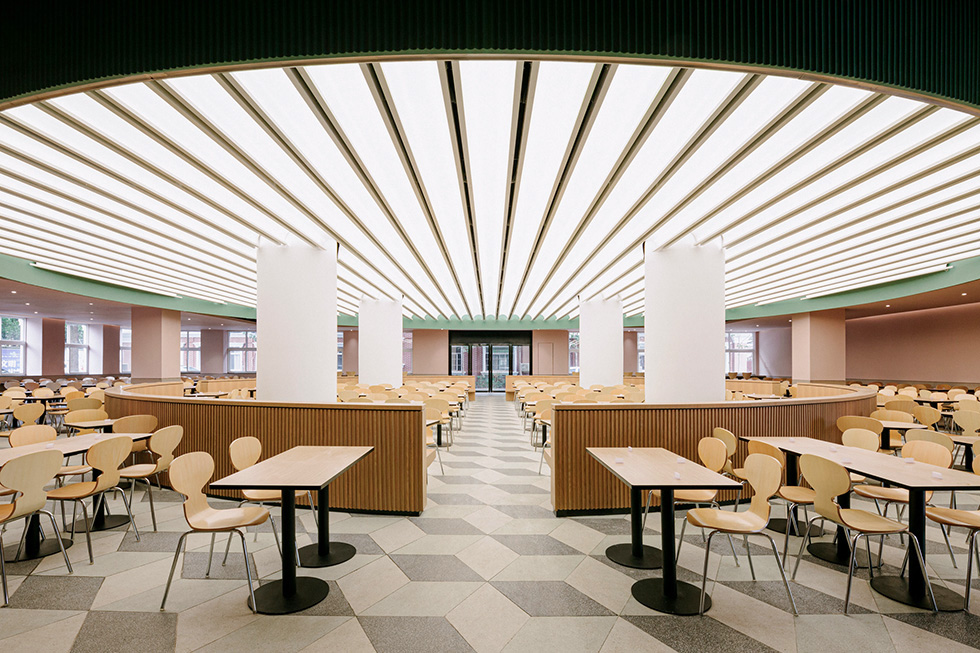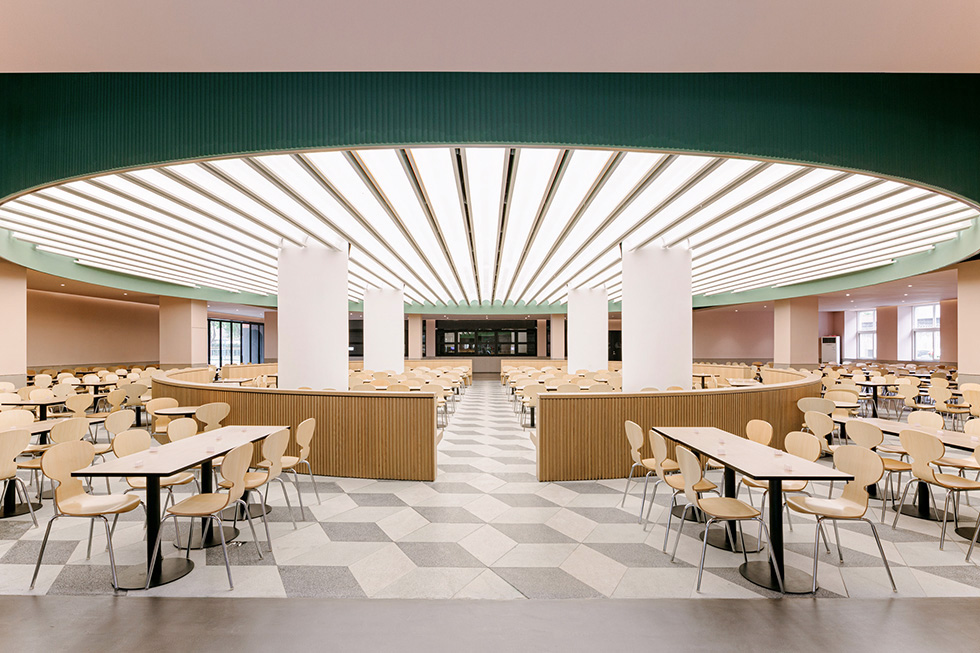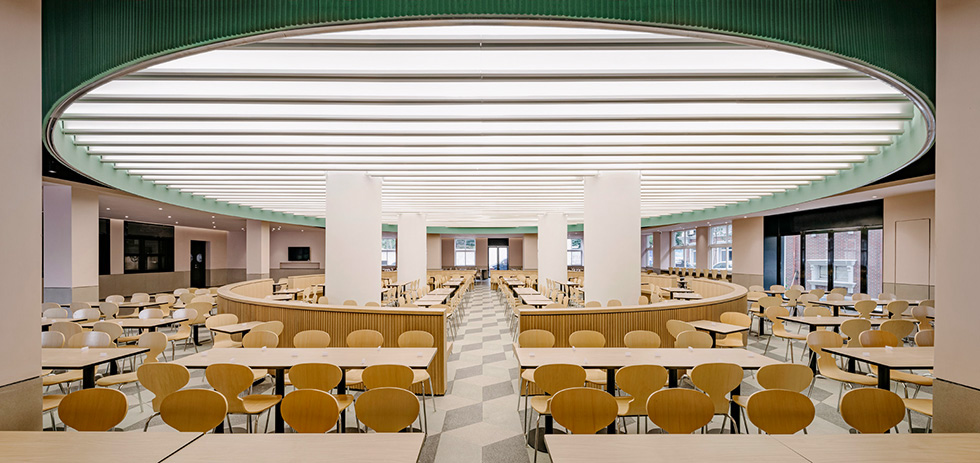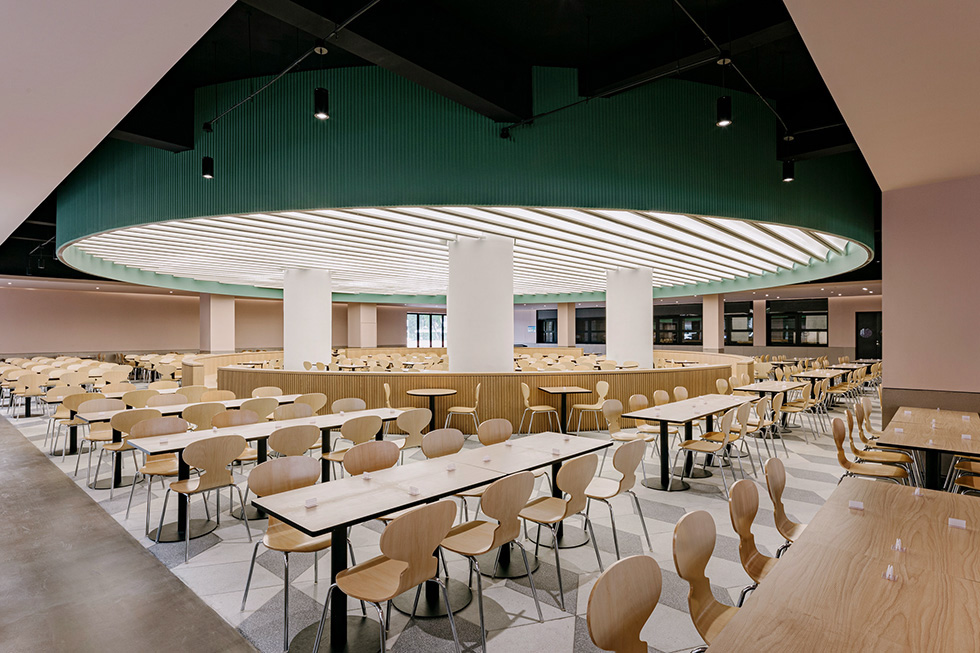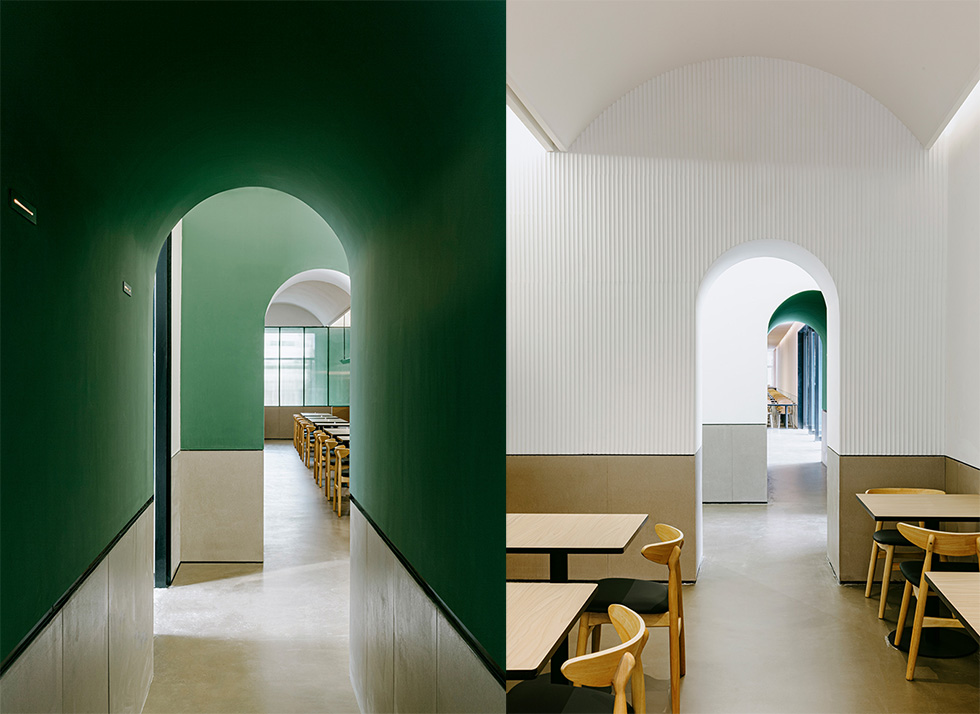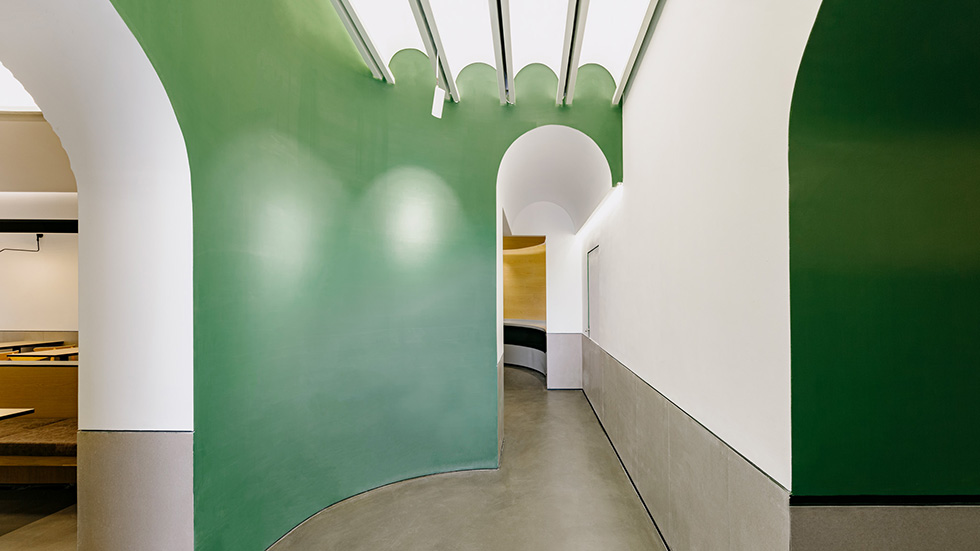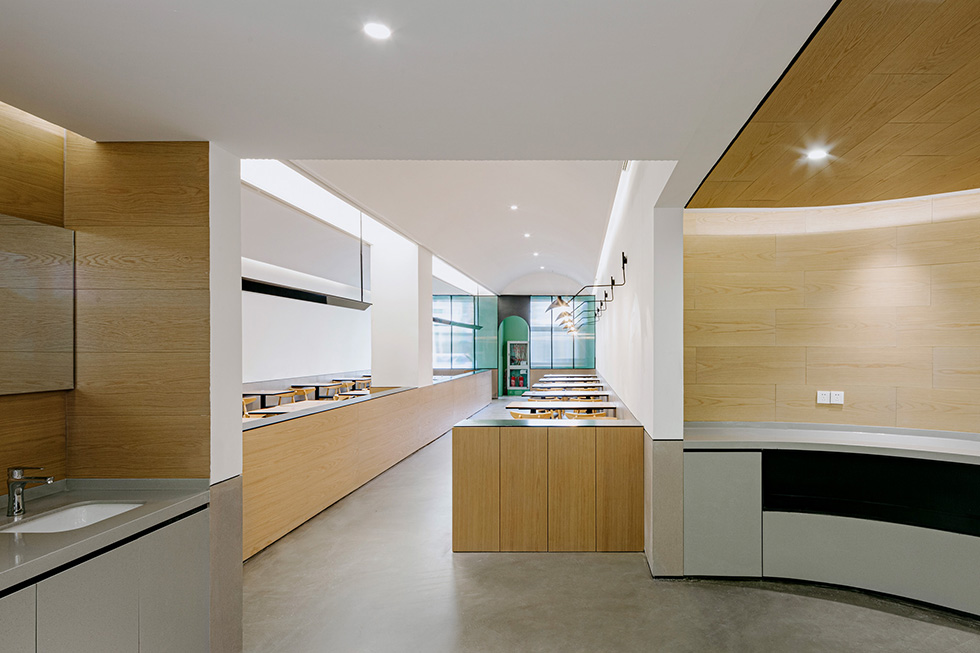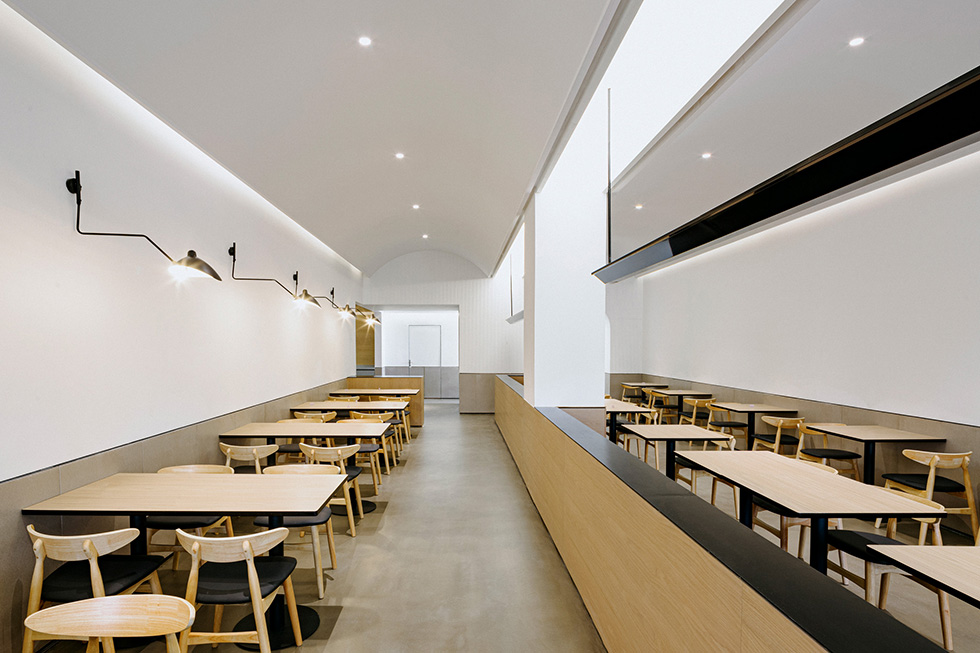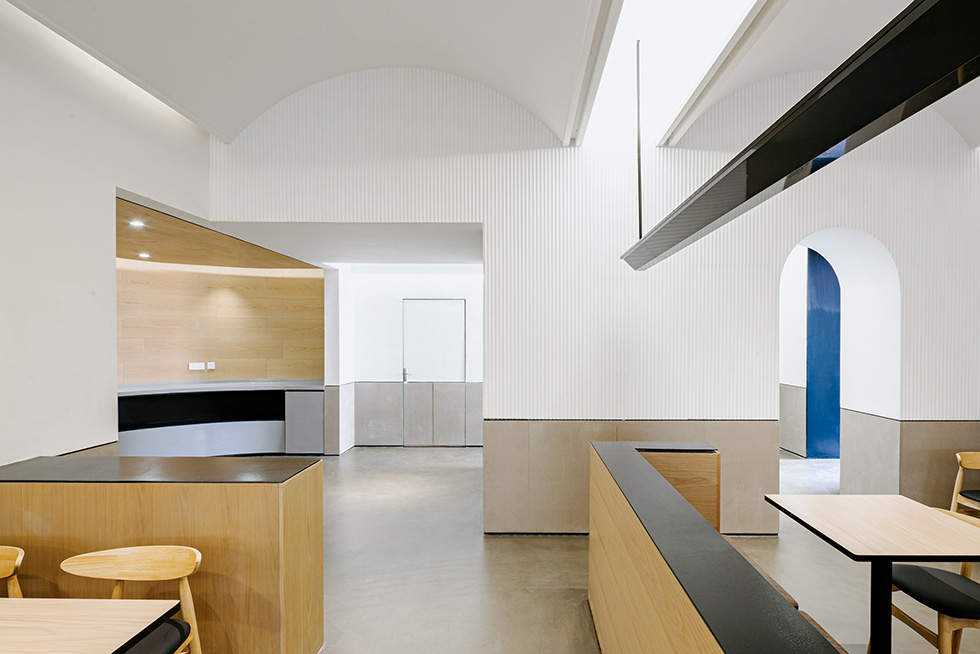| Canteen Restaurant Of Rongyi Middle School 茸一中学食堂餐厅室内更新改造设计 |
茸一中学食堂餐厅室内更新改造设计
Interior Renovation Design of the Dining Hall and Canteen of Rongyi Middle School
建筑面积(GFA):1,200sqm
2021,上海市,中国
阶段:建成
前言:“随着上海城市更新的不断深化,其已步入了以反映新时代要求、承载新内容、重视新传承、满足新需求、采用新方式为特点的城市“有机更新”新阶段,更加关注城市功能与空间品质,历史传承与魅力塑造,促进空间利用的集约紧凑、功能复合、低碳高效。”引自《2019上海城市更新白皮书》。正是在这一背景下,上海松江茸一中学希望以有限的资金投入推进校园重要公共空间的改造升级,从而激发和发掘其更多灵活性、社交性、创造性、复合性和趣味性。本次改造以学生食堂和教师餐厅为设计重点,完成其功能空间的软硬件设施更新升级。
“民以食为天”,形象的说明了食物为人类赖以生存的天地,此次改造设计以Food Hub(食社中心)为主旨理念,希望餐厅连同图书馆一同形成师生们的物理和精神“粮食”中心。同时,融入进当代校园交流互动、轻松休闲的理念趋势,设计意图点亮空间氛围,唤醒食堂餐厅多元化休闲交流的功能,从而更好的满足和服务师生。学生餐厅中央区域以四颗柱子的对角为中心,天花设计了金属圆拱光格栅,下方对应的是更轻松休闲的圆形卡座就餐区,形成了学生餐厅的视觉焦点,也大大丰富了空间氛围;同时地面水磨石配以几何立方体图案(Geometric Cubes Pattern)。教师餐厅的天花和墙面主要使用了拱形进行空间围合,既可很好的适配了原有餐厅狭长的空间体量,又与校园立面改造中拱形元素实现呼应;教师们通过前厅、过廊、自助餐区再进入就餐区,合理化动线排布,为教师餐厅带来了一个良好的空间序列。
功能布局方面:在限定备餐间位置、满足大规模用餐人数需求及实现校方安全管理的条件下,改造设计维持了学生餐厅排队等候区的位置,也同样保留了就餐区原有的尺度范围和空间的开敞性;基于教师餐厅用餐模式的改变,调整为自助取餐和人工结算的半自助就餐形式,设计对原备餐间局部重新规划布局,将其变更为自助取餐区,并同时设置了入口缓冲的前厅,增加了教师进入餐厅仪式感。同时,设置内部连廊,连通教师餐厅及学生食堂,便于师生交流及校方对食堂的管理。此外,为协调校园外立面的升级改造,餐厅入口区域也进行了适应性改造设计。
茸一中学的餐厅食堂更新改造是一次集集中式大就餐容量、低成本预算下的设计实践,同时也是短周期下各方协同努力的一次考验。我们通过重塑餐厅的空间形态,希望能为校园注入一种全新的氛围和活力,为师生带来一个更为舒适、更愿意驻足停留、更有利于互动交流的校园公共场所。
Foreword: ‘Urban renewal in Shanghai has continually evolved, to where it has today entered a new stage of organic urban renewal’, characterised by its reflection of the requirements of a new era, adopting new contents, stressing new inheritance, meeting new needs and employing new methods. It also considers more urban functions, spatial qualities, historical inheritance and charisma building, and promotes intensive, multiple, low-carbon and efficient use of space’ (White Paper of Urban Renewal in Shanghai, 2019). Against this backdrop, Rongyi Middle School in Songjiang, Shanghai, hopes to advance the renovation and upgrade of important public spaces on its campus with a limited budget to motivate and explore more flexibility, sociality, creativity, complexity and enjoyment. The renovation focuses on the design of the dining hall for students and the canteen for teachers and the renewal and upgrade of functional space facilities.
‘Food is all the world to the people’, an old Chinese saying, vividly explicates the primary importance of food. The renovation design this time is based on the concept of a Food Hub and the hope that the canteen and library can jointly become the physical and spiritual food base for students and teachers. Meanwhile, the design incorporates the conceptual trends of communication, interaction, relaxation and recreation of the contemporary campus. It aims to lighten the space ambience and activate the multiple recreational and communicative functions of the dining hall and canteen while better serving and satisfying students and teachers. The central space of the student dining hall lies at opposite angles within the four surrounding columns. Metal arches and light grids accent the ceiling, and cushioned round booths in the dining area below it form the visual focus of the hall, greatly enriching the space ambience. The terrazzo floor is matched with a geometric cube pattern, signifying here a sense of the future. The walls and ceiling of the teacher canteen chiefly use arches to enclose the space, which closely matches the long and narrow space of the original canteen and echoes the arches used in the facade renovation of the campus. Teachers traverse the lobby, corridor and buffet area to enter the dining space. The reasonable circulation brings the canteen a lively spatial sequence.
Functional layout: Considering the fixed location of the meal preparation room, a large seating capacity and safety management by the school, the renovation design maintains the position of the waiting area in the student dining hall along with the original scale and openness of the dining area. The dining mode of the teachers’ canteen is revised to a semi-cafeteria mode, with self-service pickup and manual settlement. The design alters the layout of the original meal preparation room to a self-service pickup area and installs a foyer in the entrance to enhance the teachers’ sense of ceremony upon entering the canteen. A new internal corridor connects the canteen and the dining hall and facilitates both teacher-student communication and management of the dining places by the school. To coordinate the upgrade and renovation of the campus facades, the entrance to the canteen has been renovated accordingly.
The renovation of the dining hall and canteen of the Rongyi Middle School is a design practice for a large seating capacity and low budget and a test for all parties concerned to make concerted efforts in a short span of time. By reshaping the spatial form of the dining hall and canteen, we hope to inject a new atmosphere and vitality into the campus and create a more comfortable public place on campus, where students and teachers are more willing to stay and can better interact and communicate with each other.
